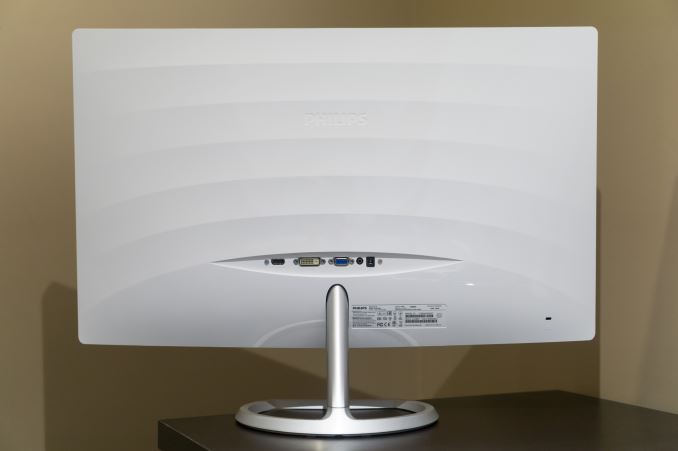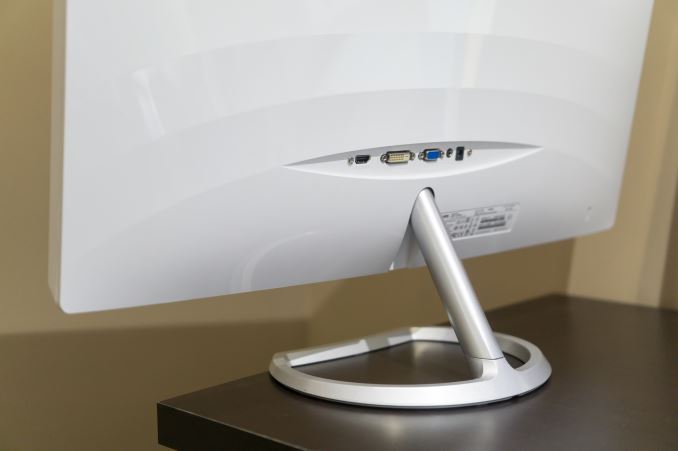A Look At QD Vision's Color IQ And The Philips 276E6 Monitor: Quantum Dots for Wider Color Gamuts
by Brandon Chester on April 28, 2016 8:00 AM EST- Posted in
- Monitors
- Philips
- Quantum Dot
- QD Vision
Final Words
QD Vision's Color IQ tech certainly delivers. In the case of the Philips 276E6, it actually delivers more than what it promises. Technically the monitor doesn't meet the Adobe RGB spec, but this is mostly due to it exceeding it rather than falling short. The gamut that it achieves is clear evidence that this quantum dot technology can be employed in monitors with relatively low prices to achieve a wide color gamut, which is something that has only existed on a small group of premium monitors until now. Given that the Philips 276E6 shows oversaturation with its red primary, I would be interested in seeing Color IQ used in a monitor targeting the DCI-P3 color space which is about to become the canon color space for UltraHD content as we move away from sRGB on a path toward eventual Rec. 2020 support.
While the Philips 276E6 is certainly a successful demonstration of QD Vision's quantum dot technology, it's difficult to say that it's successful as a product in its own right. This is a combination of two factors, with one of them being primarily an external factor.
From the last two pages it's pretty clear that Windows is not ready at all for a transition to a world beyond sRGB, and even within that gamut it makes it quite a pain to do basic color corrections. For many years, vendors who ship wide gamut displays have identified this issue and provided a fix of sorts in the form of an sRGB monitor mode which constrains its gamut so the vast majority of content on the web will render correctly without relying on proper color management. With Philips being a new entrant to this space, it seems that they were either not aware of, or underestimated the necessity of such a feature. I want to stress that this isn't something that any of these vendors should have to do, but when the most widely used desktop operating system doesn't do a good job with color management, it's something you need to do to provide a good experience for your users. Philips hasn't helped this problem by also not even providing a proper ICC color profile so that applications that actually are color managed will work correctly.
The second factor is that the Philips 276E6 is just not where it needs to be in terms of uniformity and color accuracy. Based on my measurements of two of these monitors, it's clear that Philips is allowing a large degree of variance between units. Out of the box, it's hard to tell what settings provide the most accurate image. On my original unit it was the Adobe RGB preset, while on the second unit it's the 6500K preset. Regardless of which I chose, both monitors exhibited concerning issues with color accuracy, and both had an oversaturated red primary. I'm not the only reviewer to find this, and so it's probably true of all the units which is very disappointing.
Post-calibration numbers were better in some respects, but not others. The big shift in saturation accuracy with the 200 nit calibration was very surprising to me, and it may be best to not tweak the white point at the monitor level at all. Unfortunately, making more corrections through greyscale calibration means you reduce the tonal range of the monitor further by limiting the number of distinct levels for the red, green, and blue components, which can introduce color banding. On top of that, the fact that the Philips 276E6 is trying to target a low price point means that the idea of calibrating with a $1500 spectrophotometer using $3000 software is quite absurd, and the very large variance between panels means there's not even any point in me providing an ICC profile to be used in a general manner.
In the end, I think Philips simply has some things to learn about the wide gamut monitor market, and I'm still quite interested in seeing what future products they release, along with what future products will come from other manufacturers. Philips should definitely be applauded for taking the first step toward low-cost wide gamut displays, and if they can improve their panel accuracy and include a proper sRGB color mode they'll have a very compelling product on their hands. If 1920x1080 is the target resolution to manage cost I would probably opt for a smaller panel size as well, as the pixel density is just too low on a 27" panel.
On the software side, the companies that currently ship operating systems with essentially non-functioning color management need to get their act together. Wide gamut displays are coming, and not handling multiple color standards properly is incredibly detrimental to the user experience.
As for Color IQ, I think the technology has a bright future. It's clear that it can be added to displays with only a minimal impact on price to the consumer, and the advantages are significant. The tech can clearly push a wider red primary than the Adobe RGB standard specifies, so I'd like to see some DCI-P3 monitors using the tech so consumers can take advantage of upcoming UltraHD content that will support the wider color space. As a technology, I think Color IQ will probably exist alongside film-based quantum dot technologies, as edge-lit LCDs are never going to properly support HDR standards because of their inability to do proper local dimming, and a film solution is the only feasible way to use the tech in smartphones and tablets. However, with the majority of the TV and monitor market using edge-lit displays there's a huge opportunity here to bring wider color gamuts to the masses. While I cannot really recommend buying the Philips 276E6 in its current state, I'm looking forward to future products that use QD Vision's Color IQ technology, both from Philips and from other vendors that I anticipate will adopt this technology soon.












51 Comments
View All Comments
Guspaz - Friday, April 29, 2016 - link
The U2711 was a high-end monitor, and so one of the advertised features was that Dell individually calibrated every monitor at the factory. They included with each monitor a custom calibration report that had the deltaE and such things, with graphs and whatnot. Dell provided a generic ICC profile file for the monitor, so I would imagine that the monitor itself was calibrated so that the ICC profile would match the physical monitor.If I pick option 2 (monitor set to sRGB, Windows set to ICC profile), then how does Windows know that the monitor is expecting the input to be in the sRGB colour space?
Brandon Chester - Friday, April 29, 2016 - link
To the best of my knowledge Dell's factory calibration is at the internal LUT level so you can plug it into any device and have it be accurate (the best type of calibration). The ICC is probably just something generic and I doubt it contains a VCGT for the GPU.I would choose "option 4", which is to say, just leave the OS color management alone because Dell has been playing this game long enough to know that the Windows CMM doesn't work, has made your monitor usable in sRGB without having to mess with it, and given you the option to turn on Adobe RGB when you open Lightroom or some other program.
jlabelle2 - Wednesday, May 4, 2016 - link
- If I pick option 2 (monitor set to sRGB, Windows set to ICC profile), then how does Windows know that the monitor is expecting the input to be in the sRGB colour space? -Option 2 is Option 4 with a display ICC calibration. If you are using a color managed application, it reads embedded profile and therefore will display correctly. On most of the case where it is not color managed (wall paper, Edge, modern Windows app...), the assumption is that you would use sRGB content anyway (web, pictures you received..).
The ICC display profile ensure that you are correcting the latest inaccuracy from the Dell screen compared to sRGB color space (as, even out of the box, calibrated by Dell, it is not perfect).
If you have no calibration probe, your best bet is option 4.
jlabelle - Friday, April 29, 2016 - link
- On my Mac I just set the ICC profile and everything works immediately and perfectly. -For record, it does because ...it does not really take advantage of the wide gamut in your case !
Spunjji - Thursday, April 28, 2016 - link
"for photographers and other professionals... the relatively low resolution poses less of a problem"Higher pixel density is actually huge asset - you can get a better idea of critical image sharpness without zooming in, and getting above 1080p is a massive help for getting more working area between all the toolbars.
So really, having wide gamut /and/ high pixel density would be great. Hopefully they get on that! :)
Brandon Chester - Thursday, April 28, 2016 - link
I definitely agree. Anyone who has done photo editing on a 4K or 5K display can attest to the improvement. I just meant that relative to someone who writes word documents all day, the lower resolution is probably less of an issue.Spunjji - Thursday, April 28, 2016 - link
If I could edit, I'd add thanks for the article - it was a fascinating read and I was certainly not aware that Apple had such a commanding lead in colour calibration support. Food for thought.jlabelle - Friday, April 29, 2016 - link
- I was certainly not aware that Apple had such a commanding lead in colour calibration support. Food for thought.-Let's be honest, having a less confusing way of setting once your display ICC profile (which anyway is done automatically by the software coming with your calibration probe) is NOT having a commanding lead in color calibration support. That is a silly statement.
willis936 - Thursday, April 28, 2016 - link
I'm seeing a lot of gripes about windows color management. Doesn't argyllcms take care of that? Anyone shelling out for wide gamut should also spend the $50 for a cheap colorimeter.Brandon Chester - Thursday, April 28, 2016 - link
1. Cheap colorimeters are so inaccurate that they're basically useless.2. Argyll doesn't solve any of the problems. You need your OS, its frameworks, and its applications to all understand color management and work with the CMM. ArgyllCMS is basically a tool for profiling and creating ICC profiles, it can't make software understand and utilize them.